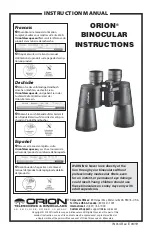
05
Waterproof / Fogproof Models
Explore Scientific binoculars are designed and built utilizing the latest
waterproof and fogproof technology (this will be noted on the product
packaging). Waterproof models are O-ring sealed for complete moisture
protection. Fogproof protection is achieved from dry nitrogen purging that
removes all internal moisture.
Tripod Mounting (tripod and tripod adapter not included)
To attach the binocular to a tripod or mono-pod, unscrew (counter-clockwise)
the cap which covers the threaded socket at the far end of the center hinge,
and set it aside in a safe place. Use a compatible binocular tripod adapter
accessory to attach your binocular to any standard tripod in a horizontal
position to provide a stable image during prolonged viewing.
Care and Cleaning
Your Explore Scientific binocular will provide years of trouble-free service if it
receives the normal care you would give any fine optical instrument.
• Do not expose non-waterproof models to heavy rain or other excessive
moisture.
• If your binocular has roll-down, flexible eyecups, store it with the eyecups up.
This avoids excessive stress and wear on the eyecups in the down position.
• Avoid sharp impacts. Use the included neckstrap to avoid accidentally
dropping the binoculars to prevent mis-alignment of the optics.
• When not using them, store your binoculars in the provided case in a cool,
dry place.
• Avoid storing the binoculars in hot places, such as the passenger
compartment of a vehicle on a hot day. The high temperature could adversely
affect the lubricants and sealants. Never leave the binocular where direct
sunlight can enter either the objective or the eyepiece lens. Damage may
result from the concentration (burning glass effect) of the sun’s rays.
• All moving parts of the binocular are permanently lubricated. Do not try to
lubricate them.
To Clean Your Binoculars Lenses
1. Blow away any dust or debris on the lens (or use a soft lens brush).
2. To remove fingerprints or other smears, clean with a soft cotton cloth rubbing
in a circular motion. A “microfiber”cleaning cloth (available from camera or
computer retailers) is ideal for the routine cleaning of your optics.
3. For a more thorough cleaning, photographic lens tissue and photographic-
type lens cleaning fluid or isopropyl alcohol may be used. Always apply the
fluid to the cleaning cloth – never directly on the lens.
For assistance or to return an item, contact Explore Scientific at 866.252.3811
or visit explorescientific.supportsync.com for return procedures.


























